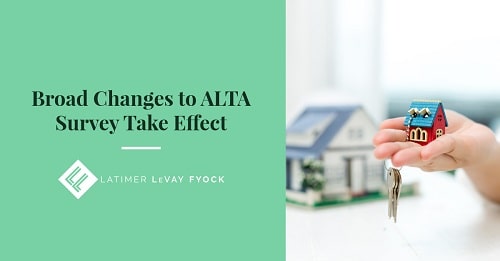What You Need To Know About The Revised ALTA/NSPS Survey Standards

In major real estate transactions, an “ALTA Survey” is a critical document that purchasers, sellers, lenders, title insurers, and other interested parties rely on to evaluate the potential risks and benefits associated with the property. Given the survey’s significance, any changes to what it must contain and how its contents are developed are of note.
Broad changes to the ALTA Survey are precisely what take effect on February 23, 2021. The modifications contained in the “2021 Minimum Standard Detail Requirements for ALTA/NSPS Land Title Surveys” were adopted in October 2020 by a joint committee comprised of the American Land Title Association (ALTA) and the National Society of Professional Surveyors (NSPS). First adopted in 1962, the standards have been modified seven times since, the last time in 2016.
If you are a real estate investor, prospective purchaser or buyer, or lender, here’s what you need to know about four key areas affected by the new minimum standards:
Limited To Survey Matters
For years, many institutional lenders required that surveys list all items shown in Schedule BII of the title commitment, regardless of whether those items were actually survey-related.
The 2021 standards make clear that the survey need only summarize survey-related matters burdening or benefiting the surveyed property and identified on the title evidence provided to the surveyor, such as rights of way or easements.
This means that the surveyor can omit matters of record that are not survey-related, regardless of whether they affect the property from a title perspective.
Additionally, the new standards under Section 6.C.viii. require the surveyor to advise the title company if, while preparing the survey, they become aware of a recorded easement not otherwise listed in the title work. Unless the title company provides the surveyor with evidence that the easement has been released, the surveyor must show the easement on the face of the survey, along with a note that it has advised the title company of its existence.
Utilities
The new standards add utility locate markings to the list of observed items that the surveyor must include in the survey, including identifying the markings' source. Surveys must now also show any utility poles on or within ten feet of the property, and include the identification of any encroaching utility pole overhangs or crossmembers (without expressing a legal opinion regarding the ownership or nature of the potential encroachment).
Modifications to Table A item 11 of the standards also impact surveyors' duties relative to underground utilities. Under the 2016 standards, the surveyor had to locate utilities based on observed evidence, plans obtained through a request to a utility company, and markings requested by the surveyor pursuant to an 811 utility locate or similar inquiry. Now, the surveyor is only required to show evidence of underground utilities based on client-provided plans and/or reports.
Mineral Interests
Mineral interests have now been added to the list of items to include in the survey that may present issues outside of those normally encountered on a survey, such as campgrounds, marinas, mobile home parks, leases, easements, and other non-fee simple interests.
Wetlands
Formerly, surveyors had to include the location of wetland delineation markers (or a note disclosing the lack of such markers) in their report. This requirement has been eliminated in its entirety.
Zoning
The standards modified the requirements relating to zoning information to clarify that any zoning report or letter provided by the client to the surveyor must be “specific to the surveyed property.” This change was designed to relieve surveyors of the responsibility of sifting through an entire zoning ordinance to determine whether and how that ordinance applies to the surveyed property.
As noted, the 2021 standards become effective on February 23, 2021. If parties enter into a surveying services contract that commences before the effective date but won’t be completed until after the 23rd, they should specifically agree in the agreement as to which standards apply.
Call Latimer LeVay Fyock With Any Questions About The New Survey Standards
At Latimer LeVay Fyock, our Chicago real estate attorneys have earned a reputation for providing sound counsel, clear guidance, meticulous documentation, and cost-effective representation in real estate transactions of all kinds and complexity. If you have questions regarding the Revised ALTA/NSPS Survey Standards or need any assistance with a real estate matter, please contact one of our real estate lawyers today.


